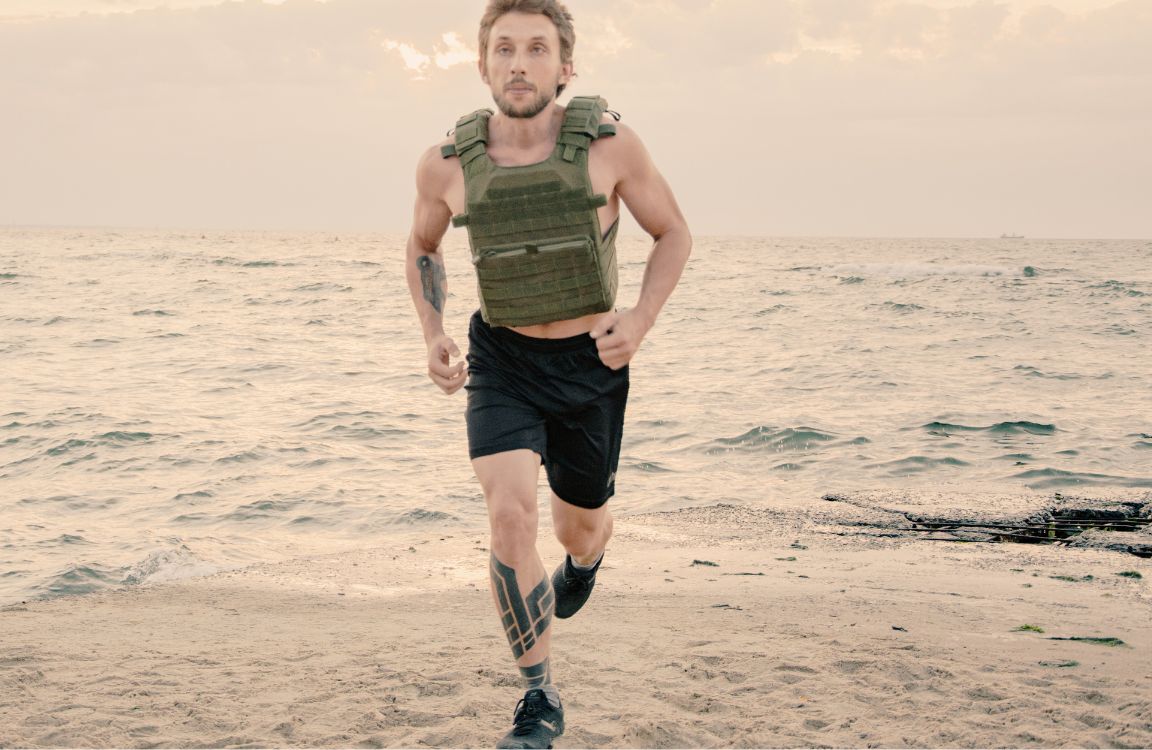
Should Runners Train with Weighted Vests?
By Jason Koop, Head Coach of CTS Ultrarunning
with CTS Pro Coach Jim Rutberg
During almost any run or hike these days you’re bound to encounter someone doing the same activity wearing a weighted vest. Popularized by Crossfit boxes, mixed martial arts gyms, and boot camp-style exercise programs, “rucking” is a new name for the old concept of an “overloaded training intervention”. The question we get from trail and ultramarathon runners, however, is whether training with a weighted vest will improve performance or make them better, stronger runners.
Quick “TL;DR” Summary
- From a sport specificity standpoint, training with a weighted vest is unlikely to make you a faster trail or ultramarathon competitor.
- Running kinematics change as the weight of the vest reaches 10% of body weight, which increases injury risks and decreases the applicability to your goal event.
- Training with a vest similar to what you’ll wear in competition (up to about 5% of bodyweight) is a good idea, but there’s no training rationale to purposely overload it.
- A more in-depth review of the study described can be found in Research Essentials for Ultrarunning, Volume 1 Issue 10, from the same authors.
Why Athletes Are Drawn to Weighted Training
Weighted training seems to make intuitive sense because a person must increase strength, power, and/or endurance to overcome the added resistance. Nearly every sport has tried some iteration of weighted training, whether through weighted vests, ankle or wrist weights, dragging tires or using heavier equipment like weighted bats or lead-filled water bottles on bicycles. It should be noted, particularly during the Olympic Games, that from a sports performance standpoint, none of these interventions stood the test of time. If they worked, Olympic medalists would still use them.
Physiologically, the concept behind overloaded training is to increase the load being lifted or carried by muscles. Hypertrophy, muscular endurance, and/or increased caloric expenditure are typical goals. Overloaded training in sport-specific contexts, like using heavier bats or golf clubs, is often an attempt to increase power. The idea there is that swinging a heavier piece of equipment will potentially help athletes generate more torque and increase rotational speed once the normal weight of the implement is returned.
The problem with overloaded training is that adding weight changes more than just the resistance an athlete experiences. It changes the whole movement. In previous iterations of overloaded training, athletes were at increased risk for injury while learning to control a heavier implement (e.g., ankle weights, weighted bats). And even if they escaped injury, when the weights were taken away there were changes in biomechanics and/or neuromuscular activation that evoked a net negative effect on sport-specific performance, even if there were improvements in muscle strength or power development.
However, carrying a vest laden with water and gear is sport specific for trail and ultramarathon. So, is there a benefit to making your vest heavier than race-day weight during training?
New Research on Weighted Vests for Trail Running
A recent study focused on ways wearing a weighted vest affected running kinematics (the geometry of motion or how you run) and running power, which in this case is used as a proxy for running economy and the metabolic cost of running (Cartón-Llorente et al., 2023).
Thus far we’ve talked about interventions that attempt to create a training advantage through adding weight to the system. The other way to consider overloaded training is as preparation for real-world activities that require carrying heavier loads (e.g., the military’s infamous marches with full packs). Runners carry lesser loads – and responsibilities – but the underlying premise is the same. If you must carry it during a race, you better prepare by carrying that weight in practice. The study referenced here fits into the category of overload training in preparation for carrying added weight during a real-world activity, an ultramarathon.
Brief Study Design Summary
Fifteen moderately trained male amateur trail runners in their 30s and 40s participated in the study. No female runners were included, which is unfortunate in general, and in this study particularly because the equipment kits required by some races are disproportionately heavier for lighter athletes, who are often female.
For the exercise trials, runners completed incremental ramp tests on a treadmill wearing a vest weighted to 0%, +5%, or +10% of their body weight. For a 165-lb (75kg) athlete, +5% would mean a pack weight of 8.25 lb (3.7kg) and +10% would mean a pack weight of 16.5 lbs (7.5kg). Each subject completed three total tests, one in each weighted condition. Weight was added to the vest in 300-gram bags and distributed front and back.
► Free Ultrarunning Training Assessment Quiz
Take our free 2-minute quiz to discover how effective your training is and get recommendations for how you can improve.
Runners were equipped with Stryd running power meters. These inertial motion sensors used gyroscopes and accelerometers in a foot pod to estimate: ground contact time (GCT), flight time (FT), duty factor (DF), stride frequency (SF), vertical oscillation (VO), stride length (SL), mean power output (MPO, in W), power output normalized to body mass (nMPO), and leg spring stiffness (LSS). They also calculated comparisons between weighted conditions at a range of speeds (i.e., 0% vs. 10% body mass at 8, 10, 12, and 14 km/hr).
Findings
The study found that running with an additional 10% of body weight significantly altered running kinematics. However, no significant changes were observed from adding only 5% of body weight (at any speed). When running while carrying an additional 10% of their bodyweight, runners showed significantly higher GCT and lower duty factor, vertical oscillation, and flight time. Visually, this would look more like a plodding runner under duress. The higher MPO suggests this as well, as it is an estimate of running economy (lower MPO would indicate better economy).
Practical Recommendations for Trail and Ultrarunners
If you are training for a trail race or ultramarathon that requires you to carry a hydration vest and additional equipment, train periodically with the pack ahead of time. Ideally, keep the fully loaded pack to between 0-5% of your body weight. Remember, the goal is to adapt to running at a total system weight of up to 105% of your body weight, not to use an excessively heavy pack for a quasi-strength training workout. So, if you’re 70 kilograms (154 pounds), a running pack weighing 5% of bodyweight would weigh 3.5 kg (7.7 lbs). Nothing terrible happens at 6% or 7% of bodyweight, there’s just no further advantage and there might be a slight increase is risk. And try to keep pack weight below 10% of bodyweight (7 kg or 15.4 lbs for our example athlete).
Enjoying This Article? Get More Free Running Training Tips
Get our coaches' best training advice, delivered straight to your inbox weekly.
What about a potential fitness or strength benefit?
Some runners will still be tempted to work out with a heavier pack (i.e., more than +10% of body weight) to achieve a higher metabolic cost in training. They’re trying to make their run harder and utilize more oxygen per minute by carrying a heavy load. It’s just not a great way accomplish that goal. As coaches, when we want to increase metabolic cost, energy expenditure, or intensity, we don’t proactively add weight to an athlete. Rather, we use faster intervals, uphill terrain, or longer efforts, but in a condition that doesn’t alter (or minimally alters) the athlete’s normal running kinematics.
Reference:
Cartón-Llorente, Antonio et al. “Training Specificity in Trail Running: A Single-Arm Trial on the Influence of Weighted Vest on Power and Kinematics in Trained Trail Runners.” Sensors (Basel, Switzerland) vol. 23,14 6411. 14 Jul. 2023, doi:10.3390/s23146411
Koop, Jason; Rutberg, Jim; Tiller, NB; Howe, Stephanie. “TRAINING SPECIFICITY IN TRAIL RUNNING: A SINGLE-ARM TRIAL ON THE INFLUENCE OF WEIGHTED VEST ON POWER AND KINEMATICS IN TRAINED TRAIL RUNNERS.” Research Essentials for Ultrarunning, January 2024, https://www.jasonkoop.com/research-essentials-for-ultrarunning. Accessed 6 August 2024.


Comments 2
Pingback: How CTS Coaches Prepare Athletes for the Unique Demands of UTMB - CTS
Great information! I have a 20lb weighted vest that I use periodically during training (even when I don’t have a race requiring a hydration vest or pack) to help increase strength. I’m 185lbs so my vest is about 11% of my body weight. The results I’m getting from this, according to the studies, are injury risk, and potential megative changes to my running mechanics, al8ng with very sore shoulders. Fortunately, I do train with a hydration vest packed with race specific gear during training for events where it’s required. It’s especially critical for UTMB events because UTMB has very specific mandatory gear requirements. I’ll be giving my weighted vest away. Thanks for the article!